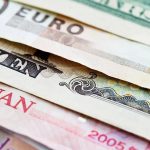Most Tradable Currencies Worldwide in 20238 min read
Reading Time: 3 minutesDo you know which are the Most Tradable Currencies? You’ll find out in this article. Despite its reputation as a “banker’s game, “Foreign Exchange (Forex) Markets provide an excellent opportunity to diversify your holdings by trading currencies.
If your portfolio is stuck, this is extremely important to remember. When other global markets are slumping, the FX markets provide a wealth of chances.
Furthermore, both newcomers and seasoned players are actively participating in online forex trading due to its accessibility and convenience.
Gaining familiarity with forex and its fundamentals is a good idea before making any form of investment, including in stocks and bonds.
As a trader or investor, your knowledge is essential to future success and financial reward. So, here are five popular currencies and their respective central banks that all traders should be aware of.
1. The All-Powerful US Dollar
Those who have dabbled in foreign exchange online trading have all dealt with the US dollar, or USD. USD or UD dollar is one of the Most Tradable Currencies in the world.
This country’s currency is managed by the Federal Reserve. The Federal Reserve Act of 1913 established it as an agency of the Federal Reserve System (the Fed).
Greenback refers to the United States Dollar, the “home denomination” of the world’s largest economy. Like every other currency, the US dollar is supported by data on the economy’s underlying health, such as GDP, employment, and manufacturing.
Online forex traders should be aware that the US dollar is highly sensitive to pronouncements made by the Federal Reserve about interest rate policy.
The United States dollar’s primary function is to serve as a reference point in currency exchanges with other major international currencies including the Japanese yen, the British pound, and the Euro.
2. Currency of Europe: Euro
The European Central Bank is in charge of the euro. Nineteen European nations use the EUR as their currency.
Many people view the Euro as the US Dollar’s archenemy. Against the US dollar, the Euro tends to move more slowly than the British pound or the Australian dollar.
The daily range for the base currency is typically between 70 and 80 pips, while daily volatility is often around 100 pips.
The passage of time is a consideration while trading Euros. Since the foreign exchange market operates around the clock, dealers always need to be thinking about their next FX (forex) trade.
When trading currency pairings based on the Euro, keep in mind that the US and British trading hours overlap from 8 a.m. to 12 EDT.
3. The Japanese Yen
The Bank of Japan controls the value of the Japanese yen, or JPY, which is used by the world’s third-largest economy.
In online forex trading, the JPY trades within the identity of a component known as “carry-trade,” which is well recognized by every investor.
When compared to most tradable currencies, the JPY’s low-interest rate seems particularly weak. Here we have the pound sterling, the dollar of New Zealand, and the dollar of Australia.
As a result, the fundamental tends to be volatile, requiring forex traders to focus on technical factors throughout the medium to long term.
4. Royal British Pound
The policies regarding the British Pound (abbreviated GBP) are set by the Bank of England.
There is no need to set up a Demat account in order to receive the funds from successful currency trades; profits can be deposited immediately into a regular bank account.
The currency itself is the asset, and while the British pound is more prone to fluctuations than the euro, it may nevertheless yield excellent profits.
The British pound, sometimes known as the cable, is known for its volatile midday trading. The British pound may go through 100-150 pip swings in either direction, and it can also trade at a tight 20 pip spread.
Most foreign exchange trading takes place during the US and British trading hours, and the most volatile currency pairs are the British pound/Swiss franc and the British pound/Japanese yen. There is often less volatility when trading in Asia.
5. The Swiss Franc of the Banks
The Swiss National Bank controls the value of the Swiss franc, often known as the CHF. There’s a fascinating dynamic between the Swiss franc and the euro that needs to be highlighted.
Just like the euro, the Swiss franc seldom experiences significant changes in the course of a single trading day. As a result, investors should anticipate this currency to move within a daily average range of 45 pips. A majority of daily Swiss franc trades take place during the British trading period.



